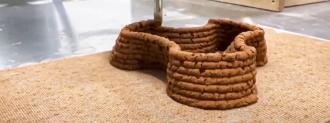Concrete is the construction material of choice for major projects for good reason: it’s strong, durable, cheap, and easy to work with. It’s even proven ideal as an “ink” for 3D printed homes and other structures, which has opened up new design options, while cutting construction timelines and costs.
But concrete is also bad for the environment.
The production of cement — a primary ingredient of concrete — accounts for 8% of human-made CO2 emissions. Transporting concrete to a building site produces more emissions, as does the energy-intensive process of mixing it.
Now, researchers from Texas A&M University have developed a technique to transform the soil already at a building site into a printable construction material.
They say this ink is more sustainable than concrete, and it could also allow for the construction of 3D printed homes and structures in hostile or extreme environments — where using concrete wouldn’t even be a viable option.
A Sustainable Construction Material
The Texas A&M researchers’ study began with the collection of clay soil samples from a colleague’s backyard. Using only environmentally friendly substances, they tweaked the soil’s composition until they had an ink that was the right consistency for 3D printing.
After printing some small test structures, to ensure the ink held together, the researchers then added a non-toxic byproduct of sugar beet processing to the mix.
This prevented the material from absorbing any water and subsequently expanding, which would compromise the building’s structural integrity. Its addition doubled the amount of weight the soil-based structures could support.
Currently, the material can withstand the pressure of up to 5 megapascals. The concrete used for residential buildings, meanwhile, can withstand up to about 17 megapascals.
The researchers now are looking for ways to increase the soil-based ink’s strength even further, with the goal of getting as close to that of concrete as possible. After that, they plan to print larger structures for testing.
3D Printed Homes Anywhere
Transforming Texas soil into a construction material that could one day be used for 3D printed homes took a lot of scientific know-how, researcher Aayushi Bajpayee told Inverse.
“Turning backyard clay into a printable formulation required the considerable design of the chemistry,” she explained. “We had to make sure that the formulation did not set too rapidly, since that would clog the nozzle, or too slowly-since that would make it impossible to put down the next layer.”
If the machinery can reach a location, 3D printed homes could follow.
But all of that effort was just the first step toward the group’s ultimate goal: making it possible to turn any soil into a usable ink. To that end, they’re developing a toolkit to analyze a soil sample and determine exactly how to convert that soil into a strong, printable construction material.
Ultimately, they hope their soil-based ink will negate some of the environmental impact of concrete, while also making it possible to build 3D printed homes in places where affordable housing is non-existent — if the 3D printing machinery can reach a location, homes could follow.
The researchers even suggest in their paper, published in the journal Frontiers in Materials, that local soil could one day be used to build medical clinics in remote jungles or maybe even structures on planets beyond Earth — no need to transport concrete to Mars if the local soil will do.
We’d love to hear from you! If you have a comment about this article or if you have a tip for a future Freethink story, please email us at [email protected].






